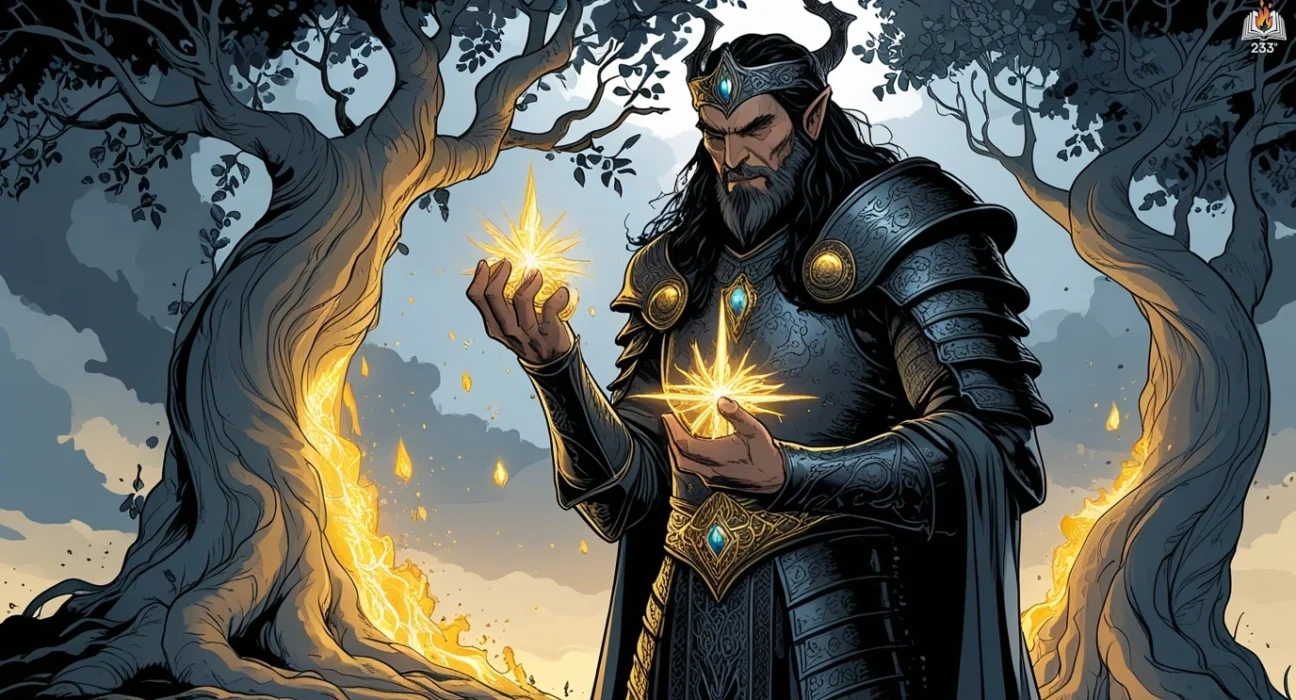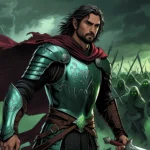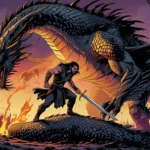The Silmarillion, written by J.R.R. Tolkien and edited posthumously by his son Christopher Tolkien, was published in 1977. The book serves as the foundational mythological work of Tolkien’s legendarium, recounting the ancient history of Middle-earth, including the creation of the world, the rise and fall of the Elves, and the origins of key elements like the Rings of Power. Structured as a collection of interconnected stories, it provides a deep historical backdrop to The Hobbit and The Lord of the Rings.
Plot Summary
In the timeless void, before the world existed, Ilúvatar, the One, brought forth the Ainur, mighty spirits born of his thought. To them, he gave a theme, and together they wove a great music, creating harmonies of unimaginable beauty. But among them, Melkor, the most gifted of the Ainur, sought to dominate the music with his own designs. His discord spread, marring the harmony, yet Ilúvatar responded with new themes, turning the dissonance into deeper beauty. The music gave form to a vision of a world, vibrant and filled with life, which Ilúvatar brought into being. Thus, Eä, the world that is, was born.
Some Ainur entered this world to shape and guard it. Chief among them were Manwë, Ulmo, and Aulë, who worked to prepare Arda, the realm destined to house the Children of Ilúvatar—Elves and Men. Yet Melkor descended as well, coveting Arda as his own dominion. His malice brought chaos, and his deeds sundered the first lights of the world, the Two Lamps. In response, the Valar retreated to Valinor, a blessed land in the West, where they created the Two Trees, Telperion and Laurelin, whose radiant light filled their sanctuary.
When the Elves, the Firstborn of Ilúvatar, awoke in Middle-earth, the Valar summoned them to Valinor for protection. Many came, including the Noldor, a proud and skilled people. Among them was Fëanor, the greatest craftsman of the Elves, who forged the Silmarils, three perfect jewels that captured the light of the Two Trees. These gems became the most treasured creations in Arda. Yet Melkor, seething with envy and hatred, poisoned the hearts of the Noldor with lies. He fled to Middle-earth, aligning himself with the monstrous spider Ungoliant. Together, they destroyed the Two Trees and stole the Silmarils, spreading darkness across the land.
Fëanor, enraged by this betrayal, led his people in rebellion against the Valar. He and his sons swore an unbreakable oath to recover the Silmarils at any cost. In their defiance, they committed the first Kinslaying, attacking their own kin, the Teleri, to seize their ships. This act of bloodshed stained their journey to Middle-earth, where Fëanor sought vengeance against Melkor, now named Morgoth, the Black Foe of the World. Fëanor’s fiery ambition drove him to an early death in battle, but his sons carried on his oath, though it cursed their lineage with grief and destruction.
Morgoth fortified himself in the northern fortress of Angband, crowned with the Silmarils in his iron crown. For centuries, the Noldor waged relentless wars against him, but his power was vast, and the toll on Elves and Men alike was devastating. Amid the conflict, alliances were forged between the Elves and the newly awakened race of Men. Among these alliances rose the tale of Beren, a mortal man, and Lúthien, an Elf maiden of unparalleled beauty. Their love defied the boundaries of mortality and immortality. Together, they embarked on a perilous quest into Angband itself to wrest a Silmaril from Morgoth’s crown. Against all odds, they succeeded, though the quest claimed Beren’s life. Lúthien’s grief moved even the Valar, and through her plea, she and Beren were granted a second life, though Lúthien chose mortality to remain with her beloved.
As the ages passed, Morgoth’s influence darkened Middle-earth. A great alliance of Elves and Men united for the Fifth Battle, Nirnaeth Arnoediad, the Battle of Unnumbered Tears. Despite their courage, betrayal from within led to their ruin. The hosts of Morgoth triumphed, and many realms of the Elves fell. Húrin, a great warrior among Men, was captured and cursed by Morgoth. His children bore the weight of this curse, their lives marked by tragedy. Túrin, his son, became a figure of immense sorrow, driven by fate to acts of both heroism and despair. His tale was one of doom, as the curse twisted his triumphs into suffering.
In this time of darkness, the hope of the world came to rest on Eärendil the Mariner, born of both Elven and human descent. With the last Silmaril in his possession, he sailed west across the treacherous seas to Valinor, seeking the aid of the Valar. His journey was fraught with peril, but his plea moved the Valar to act. They summoned their mightiest forces and descended upon Middle-earth in the War of Wrath, the greatest battle of the First Age. Morgoth’s armies were obliterated, his fortress shattered, and he himself was captured and cast into the Void, never to return.
Yet the victory came at a cost. The lands of Beleriand, where much of the conflict had unfolded, were sunk beneath the sea. The remaining Silmarils were lost as well—one cast into the ocean, one buried deep in the earth, and the third taken into the heavens by Eärendil, who was set as a star to shine as a symbol of hope. The First Age ended, and the world moved into a new era.
In the Second Age, the Men of Númenor, descendants of those who had stood against Morgoth, rose to greatness. Gifted with long life and wisdom by the Valar, they built a mighty kingdom. Yet pride and the fear of death corrupted their hearts. Defying the Ban of the Valar, they sailed west in search of immortality. Their rebellion led to the cataclysmic Downfall of Númenor, and the island kingdom was consumed by the sea.
Survivors of Númenor, led by Elendil and his sons, established the realms of Arnor and Gondor in Middle-earth. But darkness lingered, for Sauron, Morgoth’s most cunning servant, had risen as the new Dark Lord. Forging the One Ring, Sauron sought dominion over all peoples. His growing shadow set the stage for new struggles, as Elves, Men, and even Hobbits would one day unite to resist his tyranny.
Thus, the echoes of the First Age resounded through the ages to come. The Silmarils, lost but never forgotten, remained as symbols of light and sacrifice. In the heavens, the star of Eärendil shone eternally, a reminder of courage and hope, and a promise that even in the darkest of times, the light would endure.
Main Characters
Eru Ilúvatar: The supreme creator, whose Music of the Ainur brings the world into existence. His vision shapes the destiny of Arda, and his wisdom underpins its balance.
Melkor (later Morgoth): The first Dark Lord and the root of evil in Arda. His rebellion and thirst for dominance lead to the corruption of the world, the destruction of the Two Trees, and the wars of the First Age.
Manwë: The leader of the Valar and Melkor’s opposite in thought. He governs the skies and serves as the guardian of harmony in the world.
Fëanor: The greatest craftsman of the Noldor, whose creation of the Silmarils and fiery pride drive the rebellion of the Elves and the central conflict of the First Age.
Beren and Lúthien: A mortal man and an Elf maiden whose love and bravery transcend their differences. Their quest to reclaim a Silmaril from Morgoth defines courage and sacrifice.
Húrin and Túrin: Húrin, a valiant human warrior, is cursed by Morgoth, and his son Túrin lives a life of tragedy, his heroism overshadowed by doom.
Eärendil: A Half-Elven mariner whose voyage to Valinor with a Silmaril brings the Valar’s intervention and leads to Morgoth’s ultimate defeat.
Ungoliant: A monstrous spider who aids Morgoth in the destruction of the Two Trees, her insatiable hunger representing the consuming nature of evil.
Sauron: Morgoth’s lieutenant, who survives his master’s fall and rises as a new Dark Lord, crafting the One Ring to further his dominion
Theme
Creation and Sub-Creation: The Music of the Ainur depicts creation as an act of harmony and artistry, reflecting Tolkien’s belief in the divine nature of creative expression. Sub-creation—manifested in the crafting of the Silmarils—explores the power and danger of artistic ambition.
Pride and Fall: The recurring theme of hubris leading to downfall is seen in Melkor’s rebellion, Fëanor’s obsession, and the Númenóreans’ defiance of the divine Ban. These arcs mirror the universal consequences of overreaching ambition.
Good vs. Evil: A central conflict throughout the text, the battle between the forces of light (the Valar, Elves, and Men) and darkness (Morgoth, Sauron) emphasizes the resilience of hope and the cyclical nature of struggle.
Immortality and Mortality: The Elves’ immortality contrasts with the mortality of Men, reflecting differing perceptions of time and existence. Mortality, called the “Gift of Men,” is both a source of sorrow and a mysterious blessing.
Sacrifice and Redemption: Sacrifice drives much of the narrative’s heroism—whether it’s Lúthien and Beren’s quest for the Silmaril or Eärendil’s perilous journey to Valinor. Redemption, both personal and collective, is achieved through these acts of courage.
Writing Style and Tone
Tolkien crafts an epic, mythological tone in The Silmarillion, drawing inspiration from Norse sagas, Christian theology, and classical mythologies. The narrative achieves a sense of ancient timelessness by blending poetic grandeur with a meticulous attention to detail, reminiscent of historical accounts. This effect is amplified by Tolkien’s linguistic choices. The prose is elevated and archaic, employing rich metaphors and formal diction. The names of characters, titles, and locations are often rooted in Tolkien’s invented Elvish languages, which adds a layer of authenticity and depth to the world he has created.
The narrative structure of The Silmarillion contributes significantly to its unique style. The text alternates between cosmic storytelling, such as the creation of the world in the Ainulindalë, and more intimate, character-focused sagas, like the tale of Beren and Lúthien. This constant shift between grand, sweeping narratives and personal stories weaves a complex tapestry of interconnected tales. Tolkien’s writing style also demonstrates a similar duality, shifting between descriptive grandeur when depicting landscapes or epic battles and poignant intimacy when exploring the personal struggles of his characters. This interplay between the vastness of myth and the relatable humanity of the characters is central to the work’s overall impact.
We hope this summary has sparked your interest and would appreciate you following Celsius 233 on social media:
There’s a treasure trove of other fascinating book summaries waiting for you. Check out our collection of stories that inspire, thrill, and provoke thought, just like this one by checking out the Book Shelf or the Library
Remember, while our summaries capture the essence, they can never replace the full experience of reading the book. If this summary intrigued you, consider diving into the complete story – buy the book and immerse yourself in the author’s original work.
If you want to request a book summary, click here.
When Saurabh is not working/watching football/reading books/traveling, you can reach him via Twitter/X, LinkedIn, or Threads
Restart reading!








